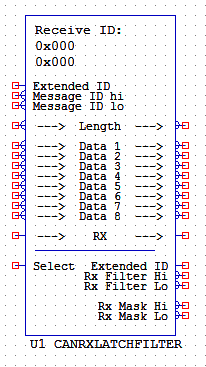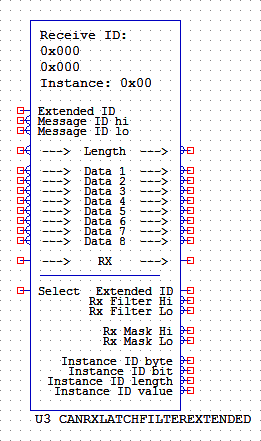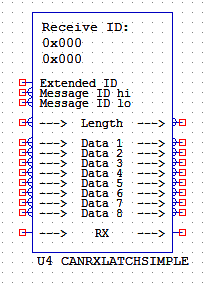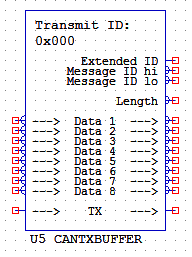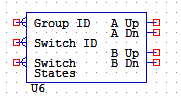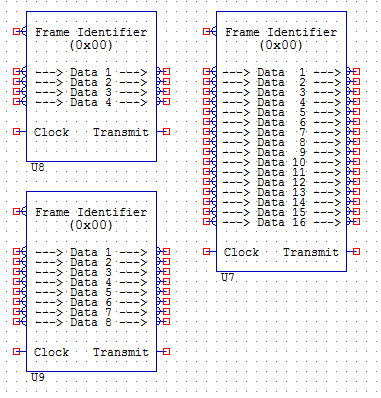Comms Objects
CANRXLATCHFILTER
CANRXLATCHFILTER is used to filter frames received by an 816CAN based on the message identifier. When the RX input goes high, the values on the ID inputs are compared to the values specified in the object's unique properties. If the values match, the length and data inputs are copied to their respective outputs, and the RX output will go high for one cycle.
CANRXLATCHFILTER also has a select input pin. When this pin goes high, the values from the unique properties are copied to the appropriate output pins. These pins should be connected to the corresponding inputs on an 816CAN object. Bringing the select pin high will re-configure the 816CAN to receive the specific frame that the RX latch is looking for. Once that frame has been received, the select pin on the next RX latch can be brought high. This is useful to ensure that high frequency frames do not prevent low frequency frames from being received. Note: do not enable the select pins simultaneously on multiple RX latches that are connected to the same 816CAN, as this will result in undefined behaviour.
CANRXLATCHFILTEREXTENDED
CANRXLATCHFILTEREXTENDED object is used to filter frames received by an 816CAN based on the message identifier and an instance ID found in the payload. When the RX input goes high, the values on the ID inputs are compared to the values specified in the object's unique properties. If the values match and the frame payload contains the correct instance ID, the length and data inputs are copied to their respective outputs, and the RX output will go high for one cycle.
CANRXLATCHFILTEREXTENDED also has a select input pin. When this pin goes high, the values from the unique properties are copied to the appropriate output pins. These pins should be connected to the corresponding inputs on an 816CAN object. Bringing the select pin high will re-configure the 816CAN to receive the specific frame that the RX latch is looking for. Once that frame has been received, the select pin on the next RX latch can be brought high. This is useful to ensure that high frequency frames do not prevent low frequency frames from being received. Note: do not enable the select pins simultaneously on multiple RX latches that are connected to the same 816CAN, as this will result in undefined behaviour.
CANRXLATCHSIMPLE
CANRXLATCHSIMPLE object is used to filter frames received by an 816CAN based on the message identifier. When the RX input goes high, the values on the ID inputs are compared to the values specified in the object's unique properties. If the values match, the length and data inputs are copied to their respective outputs, and the RX output will go high for one cycle.
CANTXBUFFER
CANTXBUFFER is a generic CAN interface Transmit Buffer. CANTXBUFFER is used to transmit a CAN frame using an 816CAN. When the TX input goes high, the inputs and unique properties are copied to the objects outputs. Note: do not enable the TX pins simultaneously on multiple TX buffers that are connected to the same 816CAN, as this will result in undefined behaviour.
ENOSWITCHDECODER
ENOSWITCHDECODER is used to decode the switch states for a specific EnOcean switch bank. Connect the inputs of the object to the outputs of an 815ENO and set the desired group and switch IDs in the unique properties. When the group and switch IDs on the inputs match the values specified in the unique properties the outputs will be updated to show the values of the individual switches on that bank.
IPLEXTXBUFFER4, 8, 16
IPLEXTXBUFFER4 is an 801IPLEX 4 value TX frame buffer. 8 and 16 versions work the same but with values of 8 and 16 respectively. IPLEXTXBUFFER is used to compose frames to be sent using an 801IPLEX. One IPLEXTXBUFFER object should be placed for each frame to be sent. The outputs of all TX buffers should be connected to the inputs of the I-Plex (the TX output will require the auto OR option to be enabled). The data inputs of the different TX buffers should be connected to their respective data sources.
The frame identifier input is used in conjunction with the clock input, in order to determine which TX buffer should be transmitting at any given time. When the clock input goes high, the TX buffer will pulse its TX output if the value on the frame identifier input matches the frame identifier that has been configured in the object's unique properties.
There are many ways to generate the frame identifier, but the recommended way is to use a COUNTERRANGE object driven by a FASTCLOCK object. The counter's range property should be set to the number of different frames in the system. The output of the FASTCLOCK can also be used to drive the clock inputs of the TX buffers. Every time the clock ticks, the frame sequence number will be incremented, and the next TX buffer will copy its input values to the inputs of the I-Plex and pulse its TX pin.

